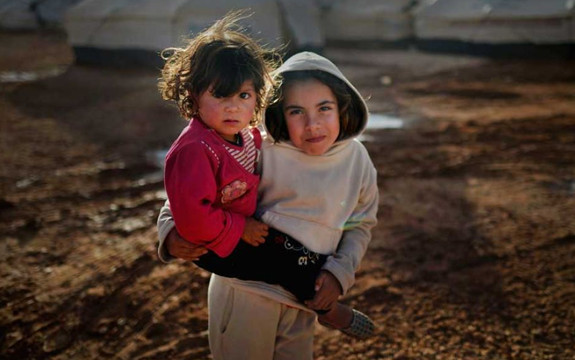Let's keep this refugee announcement in perspective

In Summary
This article originally appeared on The Drum. Read the original article.
The announcement that Australia will take an additional 12,000 refugees and provide humanitarian funding is welcome, but neither should be grounds for self-congratulatory back-slapping. It's still quite little and quite late, writes Klaus Neumann.
Yesterday Prime Minister Tony Abbott announced that Australia will resettle 12,000 refugees fleeing conflict in Syria and Iraq - in addition to the annual humanitarian intake of 13,750 people (including some 6000 refugees).
The Government will also provide about $44 million for humanitarian aid in countries neighbouring Syria.
Both the increase in Australia's resettlement quota and the additional financial commitment are welcome. But neither should be grounds for self-congratulatory back-slapping.
As World Vision CEO Tim Costello pointed out yesterday, for years aid agencies had appealed to Australians to donate money for humanitarian relief in the Middle East. It took the image of a dead child - four years after the Syrian civil war began - to get the majority of Australians interested in a conflict that has driven more than four million people from Syria.
We should also keep the Government's announcement in perspective.
An additional $44 million for emergency relief is comparatively little when considered in the context of the overall funding required by the UN refugee agency, UNHCR, or by humanitarian organisations caring for Syrian and Iraqi refugees. It is small change in comparison to the billions of dollars Australia has spent since 2012 on its offshore detention facilities in Nauru and Manus.
What about the additional resettlement places made available by Australia? Even before yesterday's announcement, Tony Abbott was saying that "on a per capita basis, no country on earth takes more refugees through the UNHCR than we do". That is true in relation to the UNHCR resettlement program. But last year this program catered only for about 105,000 people - a tiny fraction of the world's 59.5 million displaced people at the end of 2014.
Yesterday, Germany's vice chancellor Sigmar Gabriel said that he expected his country to admit half a million refugees each year for several years to come. While this statement may turn out to be hyperbole, it seems certain that Germany can expect an influx of about 800,000 asylum seekers this year, and that many of them will be allowed to stay.
Last year, Sweden (whose population is about 40 per cent of Australia's) admitted more than 30,000 Syrian asylum seekers; since late 2013, the government in Stockholm has accepted all Syrians seeking asylum in Sweden.
The size of Australia's humanitarian intake is also modest when seen in the context of the overall migration program of currently 190,000 permanent arrivals per annum - more than twice as many as 20 years ago.
Finally, Australia's humanitarian resettlement program, including the additional intake of refugees from Iraq and Syria, is small when compared to the number of refugees resettled under previous governments.
The best-known case of a generous resettlement policy is the accommodation of some 70,000 Indochinese refugees under prime minister Malcolm Fraser. The largest number of refugees settlers to arrive in a calendar year, however, was recorded in 1949.
Then, Australia resettled more than 75,000 so-called DPs, or Displaced Persons, through the auspices of the International Refugee Organization. Most were Eastern Europeans who had become stranded in Germany or Austria. Then, Australia's population was less than a third of what it is now. That is, in one year, Australia accommodated one refugee for every 100 Australian residents - while the country was experiencing a housing shortage and while it was arguably far less affluent than it is today.
This is not to suggest that in the past Australia was always more generous. In fact, in one respect, Australia's response to refugees in the late 1940s and throughout the 1950s and 1960s should not be emulated. Until 1975, Australia tended to resettle refugees because they could be expected to provide much-needed labour.
At times, the selection criteria for refugee settlers were more stringent than those for other migrants. In 1949, for example, Australia selected refugee applicants only if they had a clean bill of health. And until 1972, when the McMahon government admitted a handful of Asian Ugandans who had been expelled by the dictator Idi Amin, the immigration authorities accepted refugees only if they were white.
We shouldn't return to that kind of selective response to displacement. But there is every indication that the Government is intending to do just that.
"It is important that we don't bring in anyone from this troubled region who might ultimately be a problem for the Australian community as far as we humanly can," Tony Abbott said yesterday.
Apparently the Government believes that Muslim men, in particular, might cause trouble. But somebody suffering from, say, diabetes, or too old to join the workforce could also be conceived of as a prospective problem.
In 1975, Gough Whitlam broke with a tradition whereby Australia tried to pick only the "best types" when recruiting refugees for resettlement. The teams he sent to Hong Kong, Malaysia and Singapore were instructed to select only those Vietnamese refugees who had no prospects of being admitted to other Western countries and who did not meet Australia's standard migration criteria.
Now, too, Australia ought to select those most in need, rather than those most needed by us or those promising to integrate most easily (because they are young, in good health and highly qualified, or because they are Christian).
Klaus Neumann is the author of Across the Seas: Australia's Response to Refugees, which was published by Black Inc. in June. He is professor of history at Swinburne University.

